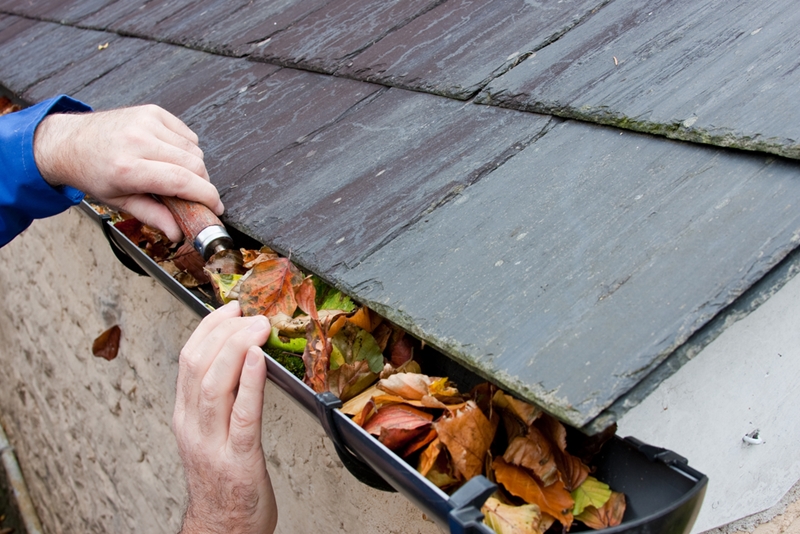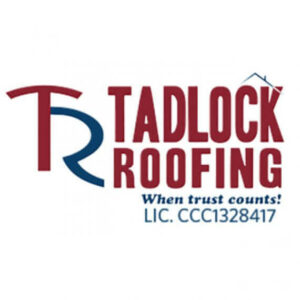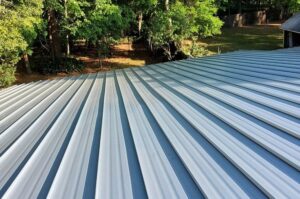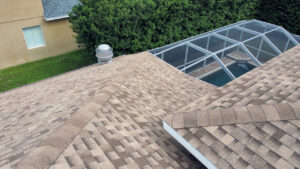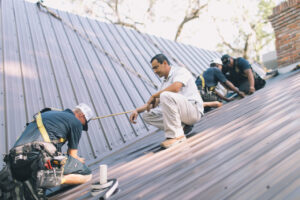Our team at Tadlock Roofing was recently approached by Redfin to contribute some of our roofing knowledge to an article about Preparing Your Roof for Fall and Winter. We thought it might be helpful for some of our readers to post the article on our blog as well:
Now that fall has arrived and winter is right around the corner, it’s time to start tackling those critical projects before the weather changes. Perhaps the most important item to cross off your list is your roof. Whether you live in Salt Lake City or Portland, if you don’t take the time to properly prepare your roof for inclement weather, you risk damage to your home and an uncomfortable season ahead. That’s why we gathered notable roofing experts from around the country to weigh in on some of the most frequently asked roofing questions.
Read on to make sure your roof is ready for whatever Mother Nature can throw at it!
When is the ideal time of year to have my roof worked on?
It’s best to install roofs in the spring, summer, and fall. Direct sunlight plays a big part in ensuring that the asphalt shingles on your roof have enough time to activate the self-sealing feature and to keep harsh elements like rain, wind, and snow out. When roofs are installed in the spring, summer, and earlier to mid-fall, they have months of direct sunlight to prepare them before the serious weather hits. For that reason, we prefer to install new roofs in plenty of time to avoid upcoming snowfall.
Can roofing be done in cold weather?
While we can make smaller repairs a little further into the fall, and even in cooler weather, we still need dry, sunny conditions to ensure that the work we do on a new roof installation is completed properly. Too much snow can affect your shingles’ ability to bond, and materials that are installed in freezing temperatures are typically brittle and can crack. It’s also not safe to be up on roofs in snowy or icy weather. If you’re hoping to get a roof put on before the winter hits, it’s best to try to install in September, October or early November at the latest, so you avoid any early snowfall. – Kris Werner, Werner Roofing
How long will it take to install a new roof?
Well, this depends on several factors. First, how large is the roof to be replaced? Roofs are measured by the square foot in blocks of 100 square feet. So, for example, a 3,000 square foot roof would be 30 squares (3,000/100). Second, what is the material of the roof covering to be replaced? Asphalt shingle roofs can be replaced much quicker than a metal or tile roof. Finally, the last thing to consider is how complex the roof being replaced is?
Once we have defined all of these, we can begin to deduct how long a new roof will take to install. An asphalt roof that is 30 squares may take just 6 to 7 hours if it is a simple roof design. However, if it is very complex, it could take 10-12 hours to complete. Consequently, a 30 square roof to be replaced with a metal standing seam roof may take 3-4 days for a simple design, and if it is complex, it could take a week or more. Tile and slate roofing materials are similar to standing seam metal roofing installation times.
Can I stay in my house while my roof is being replaced?
You can absolutely stay in your home while your roof is being replaced if the noise isn’t an issue, given you consider some safety precautions. When exiting or entering the house, it is essential to remember that shingles or debris could slide off the roof. Additionally, be careful walking around the house during the roofing installation as sometimes nails might be hiding in the grass. Professional roofers take every safety measure to prevent injury like using a magnet to collect any fallen nails and discarding debris in one or two centralized locations. However, it is always best to exercise caution in any construction site. – Chris Baker, President of Baker Roofing & Construction, Inc.
How long can I expect my new roof system to last?
The lifespan of a new roof depends on the materials and workmanship that went into it. With common sense and regular care, no matter the material, your new roof will last for decades. Before we compare materials, here are three things to keep in mind:
1. Proper installation is vital to having a roof system that will hold up over time. Always use a professional roofer. Shoddy installation can end up being very expensive.
2. Some materials are more durable than others, or more appropriate for your local climate, such as if you are in a heavy storm area, or one subject to hot, penetrating solar radiation. Select materials appropriate to your area and the style of your home.
3. Roofs that are inspected and maintained last longer than roofs that are neglected. Seasonal inspections for damage, such as after a storm, can help catch small problems before they become big ones. Perform regular removal of debris, such as leaves and branches, as these can lead to pooling and damage to the roof and underlayment, leaving you with mold or other issues.
Here are typical lifespans of common roofing materials under moderate conditions and regular care:
● Asphalt or composite shingles 20-30 years, premium brands up to 50
● Wood/cedar shakes 30 years
● Cement or clay tiles 100+ years
● Slate 75-100+ years
● Copper 70+ years
● Metal 40-80+ years
New roofing materials on the market may simulate the look of traditional roofing materials, like wood or cedar,
and last longer, with better fire resistance.
Is it normal for a new roof to lose granules?
It is common to see some granule loss after a new asphalt shingle roof installation. Loose granules often remain from the manufacturing process where they are added to make sure the material is fully saturated with the required granule layers. It is normal to see a wash off of these excess granules for the first few months. The process will usually stop on its own. However, if after several months, the loss is continuing or the roof looks damaged or has changed color, call your installer to have him check the situation. If there is a defect, it should be covered by the manufacturer’s warranty. – Tom Romney, President of Prestige Roofing
How can I extend the life of my roofing system?
Extending the life of your roofing system can save you thousands of dollars. Start with periodic inspections. This way you will be able to see the need for a small repair before it cascades into the need for a bigger repair or even an entirely new roof.
A few weeks ago, I looked at a commercial roof that had a small area of roofing material blown off. The wind was blowing and we noticed that a much larger area was about to blow off. We were able to secure the roof before it sustained further damage.
The same thing can happen on a residential roof. Shingles are interdependent and seal to the shingle above and below. If you get one row of shingles blown off, the wind can get under the adjoining shingle and blow off an entire section of the roof.
A key point in doing inspections is the need to stay safe. Roofers spend a lot of time talking and training about safety techniques. Getting on a roof is not for everyone. You can look at a roof from the front or back yard and occasionally see some damage, but you might miss some things that you would not see unless you are on the rooftop. I’ll admit that this is a worst-case scenario, but I’ve seen broken arms and legs. Not everyone should be on a roof. If this is you, call a professional.
We do a lot of free inspections to check for damage. If you have a professional look at your roof, check their online reviews, then verify that they have Workman’s Compensation Insurance before they climb up there. You don’t want to be responsible for anyone’s hospital bill. – Neil Cagle, President of All American Roofing, Inc.
What steps should you take to prepare your roof for winter months if you live in a warmer climate?
1. Clean Your Rooftop
Not only should you keep your gutters clean, but it’s also important to keep leaves, branches, pine needles, and other debris off your rooftop at all times. Even small bits and piles of debris may begin to rot or mold, which will break down your roofing system over time.
2. Check Your Roof for Damage and Deterioration
After your rooftop is clean and debris-free, take a close look at the entire surface and all parts of your roof system. What to look for: Loose, broken or missing shingles. Replace them or have them replaced. Additionally, check the flashing around your chimney, vent pipes, skylights, and any other roof projections. Make sure they are properly sealed to keep out rain and moisture. If your roof is more than 15 years old, it may be time to replace it. Over time, falling leaves and debris will collect in your gutters. If you are comfortable working on your rooftop, you should:
- Use a hose to rinse the gutters out and flush water through your downspouts; you might need a chimney brush or broom handle to push through any stubborn clogs. Clean up the debris you remove from the downspouts and gutters so it doesn’t collect at the end of the pipe.
- Install leaf guards on your gutters to prevent falling debris from accumulating. Add extensions to your downspouts to send the flowing water farther away from your home’s foundation. – Tadlock Roofing
Will I need to replace my skylights and gutters at the same time as my roof?
To ensure the integrity of the entire roof, we always replace skylights when we’re installing a new roof. This means we can cover the whole roof with our workmanship warranty – guaranteeing security for the homes we work on. Working around existing skylights can save a little money, but we’ve found it’s not worth the risk. Gutters are different. Because they’re not part of the watertight roof surface, they don’t need to be installed together with the roof. Getting a roof and gutters installed together is efficient, and has benefits like making sure they’re covered by the same workmanship warranty and look great together. But if you need a new roof and your old gutters still work well and look good, there’s no reason to replace them until they need it. – Daniel Southwell, Marketing Director of Joyland Roofing
What are the best ways to prevent winter ice-related issues from happening to my roof?
Ice damming is the buildup of ice and snow on steep-sloped roofs. When snow melts on your roof and then refreezes as temperatures drop, the ice pushes its way under your shingles and lifts them up as it expands. Ice damming can result in roof leaks, damage to your insulation, and water penetration into your home.The best way to prevent ice-damming and other winter-related issues for your roof is to keep your roof cold. A difference in temperature between the cold outside air and the warmth of your home is a contributing factor for ice issues. Before winter weather arrives, make sure that you have good insulation in your attic. You should also locate and seal any places in your attic where cold air seeps in. If you are planning to replace your roof in the future, you should install ice and weather shield minimally 24 inches into the warm wall. For maximum weather protection, we recommend you install ice and weather shield six feet high along the gutter edge and three feet wide down the center of the valleys. Ice and weather shield is a leak barrier installed under your shingles. This product can prevent leaks caused by wind-driven rain and ice damming. – Richard Szpytek, Vice President of Feze Roofing, Inc.
See the full article here: https://www.redfin.com/blog/preparing-your-roof-for-fall-and-winter/

